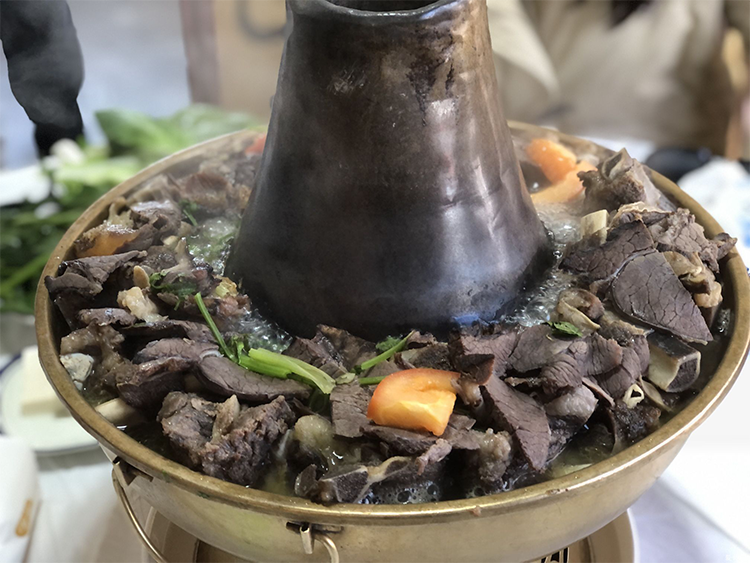Yak Beef Hot Pot: Ultimate Qinghai-Tibet Winter Guide
Introduction:
Imagine sitting around a simmering pot at 3,000 meters altitude, dipping a thin slice of ruby-red yak beef into a rich, aromatic broth, and tasting a warmth that cuts through the cold. Yak beef hot pot, born on the Qinghai-Tibet Plateau, is both a comforting winter feast and a living tradition—waiting for travelers to discover its bold flavors and high-altitude wisdom.
1. Origin and History: Survival Wisdom from the Roof of the World
Yak beef hot pot emerged as a practical and nourishing response to the Qinghai-Tibet Plateau’s harsh climate. Centuries ago, nomadic herders needed quick, efficient ways to cook and stay warm in subzero temperatures. Historical records show that during the Tubo era (7th–9th centuries), people were already simmering yak bones for broth and cooking thin meat slices by the fireside. The method conserved limited fuel, provided sustained heat, and concentrated nutrients—evolving over generations into today’s signature highland hot pot.
2. Cultural Significance: A Bond Between People and Place
On the Plateau, yak beef hot pot is far more than a meal. It’s a centerpiece for family gatherings, New Year celebrations, and festivals like horse racing. The communal pot symbolizes reunion and hospitality: hosts serve hot pot to honor guests, and there’s a local saying that the more the broth boils, the deeper the friendship. Eating together expresses the region’s philosophy that food equals energy and sharing equals warmth.

3. Ingredients: Gifts from the Pristine Highlands
- Core star—yak beef: Raised between 3,000 and 5,000 meters in nearly pollution-free pastures, yak beef is darker red and leaner than typical beef. It’s rich in heme iron and amino acids, with fat content around 3% (compared to roughly 20% in ordinary beef). Tender cuts have a subtle milky aroma and concentrated beefiness.
- Highland mushrooms: Wild matsutake, morel, and golden chanterelles grow naturally at altitude and intensify umami while supplying rare trace minerals. Their annual yield is a fraction of lowland cultivated mushrooms.
- Soulful broth: A long-simmered stock made from yak bones and traditional Tibetan herbs like danggui (Chinese angelica) and goji berries. After eight hours of slow simmering, the broth turns milky and richly flavored. Each kilogram of bone yields only about 400 ml of concentrated stock, explaining its treasured status.
4. Cooking Method: Patience and Technique
Authentic yak hot pot is a ritual. Yak bones are split to expose marrow and briefly stir-fried with ginger to awaken aroma, then covered with glacier or meltwater and brought to a boil before simmering for hours. Careful skimming keeps the stock clear. The herbal sachet follows Tibetan nutritional principles, blending warming medicinal ingredients rather than merely seasoning. Meat slicing is precise: tender loin is cut against the grain into 0.15 cm thin slices so they cook instantly while retaining bite.

5. Flavor and Texture: A Three-Part Symphony
First comes the broth—rich, silky, and faintly sweet, with no gamey aftertaste. Second is the meat—eight seconds in the pot gives yak slices a pleasing combination of tenderness and chew, carrying herbal and grassy notes. Third are the mushrooms—the matsutake, after absorbing the broth, offers a briny, abalone-like springiness. Dip everything into sauces made from Tibetan chilies, buttered tea, or yak butter and spices to amplify the hot, numbing, and savory layers.
6. How to Eat: The Highland Ritual
Local etiquette follows a sequence: meat first, mushrooms next, vegetables last. Meat jumps-starts the broth’s flavor, mushrooms soak up concentrated juices, and hardy root vegetables like round white radish tame richness. Locals time it precisely—count eight seconds for meat, simmer mushrooms about three minutes, and blanch greens until translucent. Sauce choice matters: younger diners favor spicy chili mixes; newcomers to altitude often prefer yak butter-based dips or a special barley-wine sauce that brings out the meat’s sweetness.

7. Tasting Tips: Best Practices for Authentic Flavor
- Perfect pairings: Order both brisket (marbled) and tenderloin (lean) and combine matsutake with chanterelles.
- Hidden trick: When the pot boils, ladle half a bowl of plain broth and sprinkle scallions to savor the pure stock flavor.
- Timing: Because boiling point decreases at altitude, allow roughly 20% longer cooking times than at sea level.
- Drinks: Sweet Tibetan tea soothes spiciness, while a small glass of barley wine warms from within.
8. Traveler Tips: Practical High-Altitude Advice
- Recommended restaurants: In Lhasa try the long-standing Snow Plateau Yak Hot Pot; in Shangri-La visit Pure Land Yak House for mountain views.
- Budget: Expect about CNY 80–120 per person for a set with multiple meats, vegetables, and unlimited soup refills.
- Cautions: First-time visitors should choose mildly spiced broths to protect sensitive stomachs.
- Seasonality: Autumn (September–October) is prime time when fresh matsutake appear.
- Manners: Receive tea with both hands and avoid sorting through medicinal herbs in the pot—respect local customs.

9. Home Version: Recreate Highland Flavors Easily
You don’t need to be on the Plateau to enjoy yak hot pot. Order frozen yak beef online or use lean beef as a substitute. Simmer oxtail and chicken carcasses with a spoon of powdered milk to mimic the broth’s creamy note. Replace wild matsutake with shiitake and cremini. For thin slices, partially freeze the meat before cutting. Boost depth with a spoon of tahini or white sesame paste, and build a dipping sauce from spicy bean paste, peanut butter, and sesame oil. Keep the pot gently boiling to simulate the highland cooking rhythm.
10. Conclusion: More Than a Meal
Yak beef hot pot is a sensory key to the Qinghai-Tibet Plateau—an edible story of survival, ceremony, and hospitality. Each slice of meat carries sun and wind from alpine meadows; every spoonful of broth encapsulates centuries of highland care. When you next travel to the Roof of the World, sit by the simmering pot and let this fiery, fragrant tradition become one of your warmest memories.


